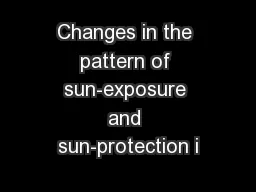

A Smith 1 SHarrison 1 M Nowak 1 P Buettner 1 R MacLennan 12 1 Skin Cancer Research Group School of Public Health Tropical Medicine amp Rehabilitation Sciences James Cook University Townsville Queensland Australia ID: 415926
Download Presentation The PPT/PDF document "Changes in the pattern of sun-exposure a..." is the property of its rightful owner. Permission is granted to download and print the materials on this web site for personal, non-commercial use only, and to display it on your personal computer provided you do not modify the materials and that you retain all copyright notices contained in the materials. By downloading content from our website, you accept the terms of this agreement.
Slide1
Changes in the pattern of sun-exposure and sun-protection in young children from tropical AustraliaA. Smith,1 S.Harrison,1 M. Nowak, 1 P. Buettner,1 R. MacLennan1,2
1. Skin Cancer Research Group, School of Public Health, Tropical Medicine & Rehabilitation Sciences, James Cook University, Townsville, Queensland, Australia.
2. Queensland Institute of Medical Research, 300 Herston Rd, Herston, Queensland, Australia.Slide2
BackgroundAustralia has one of the highest rates of skin cancer in the world1,2 particularly in north QLD.3Life-time risk of skin cancer is linked to sun-exposure in childhood.4 The strongest risk
marker for melanoma (number of melanocytic naevi)5 is directly linked to high levels of sun-exposure in early childhood.
6, 7
References
1. Marks R. Epidemiology of melanoma. Clin Exp Dermatol 2000;25:459-63. 2. Lomas A, Leonardi-Bee J, Bath-Hextall F. A Systematic Review of worldwide incidence of 351 Non-melanoma skin cancer. Br J Dermatol 2012 Jan 17. [Epub ahead of print] 3. Buettner PG, Raasch BA. Incidence rates of skin cancer in Townsville, Australia. Int J Cancer 354 1998;78:587-93. Erratum in: Int J Cancer 2001;93:302-3.
4. Whiteman DC, Whiteman CA, Green AC. Childhood sun exposure as a risk factor for 368 melanoma: a systematic review of epidemiologic studies. Cancer Causes Control. 369 2001;12:69-82. 5. Armstrong BK, English DR. Epidemiologic studies. In: Balch CM, Houghton AN, Milton GW, 371 Sober AJ, Soong S-j, Editors. Cutaneous melanoma: clinical management and treatment 372 results worldwide, Ed.2. Philadelphia: JB Lippincott; 1992. p. 12-26.
6. Harrison SL, MacLennan R, Speare R, Wronski I. Sun exposure and melanocytic naevi in 374 young Australian children. Lancet 1994;344(8936):1529-32.
7. Whiteman DC, Brown RM, Purdie DM, Hughes MC. Prevalence and anatomical
distribution
of naevi in young Queensland children. Int J Cancer
2003;106:930-3Slide3
MethodsTwo cohorts of ONE (12-23 months) & TWO year-old (24-35 mo) children from tropical Australia (Townsville 19.16◦S), were compared: Cohort 1 (n=201) recruited in 1991 from hospital birth recordsCohort 2 (n=463)
recruited 1999-2002 via childcare centres Children’s phenotypic characteristics were assessed Parents completed questionnaires detailing children’s
:demographic characteristics sun-exposure
sun-protective practicesSlide4
Results - 1SUN EXPOSURE Children from cohort 2 (1 & 2 year-olds [yo]):visited the beach more often (both age groups p<0.001) swam in an outdoor pool more frequently (1yo p<001; 2yo p=0.03)
1yo spent more hours outdoors in the previous year than 1yo in cohort 1 (median 2.8 vs 2.2 hr/day, p=0.002; 2yo NS)1yo from cohort 2 spent more hours playing in water in warmer weather than 1yo in cohort 1 (72 vs 42hr/yr, p=0.039; 2yo NS) but less time swimming with their back exposed (both ages, median 0hrs/yr vs 9hrs/yr p<0.001)
By age 2 years:more than half the children in both cohorts had been sunburntSlide5
Results - 2SUN-PROTECTION More children from cohort 2:“almost always “wore a sun-protective shirt when swimming in summer & winter (both ages & seasons, p<0.001) regularly wore sunscreen (in summer, both ages p<0.001); winter 1yo p=0.023, 2yo NS)RISK FACTORS
Fewer children in cohort 2 had been sunburnt on the posterior trunk (both ages p<0.001)Fewer children in cohort 2 (1yo 15% vs 40%; 2yo 39% vs 75%;) had acquired melanocytic naevi on their posterior trunk (both ages p<0.001)
Children in cohort 2 tended to have fewer naevi on their posterior trunk (median 2 vs 0 at 2yo) than children in cohort 1 (both ages; p<0.001).Children in cohort 2 were less likely to have acquired naevi elsewhere on their body (both ages; p<0.001)Slide6
ConclusionsTime spent in the sun did not change much in the 8-years that elapsed between cohorts.There was however, a significant improvement in sun-protective practices in very young children from a region with a substantial skin cancer burden.
This ↑ in swim-shirt and sunscreen use between cohorts coincided with a
reduction in the development of melanocytic naevi (MN), particularly on the posterior trunk. The reduced burden of MN observed in the most recent cohort m
ay confer some protection against melanoma.Skin cancer primary prevention campaigns are having some effect although more emphasis is needed on reducing sun-exposure.